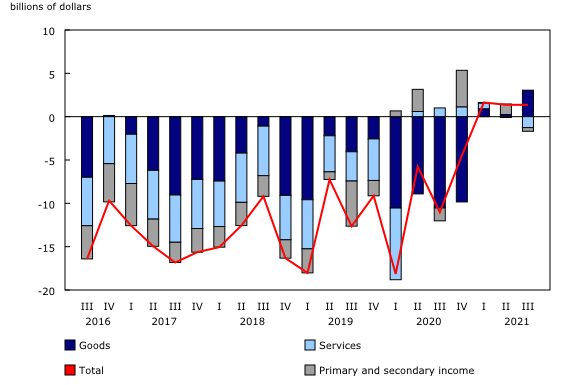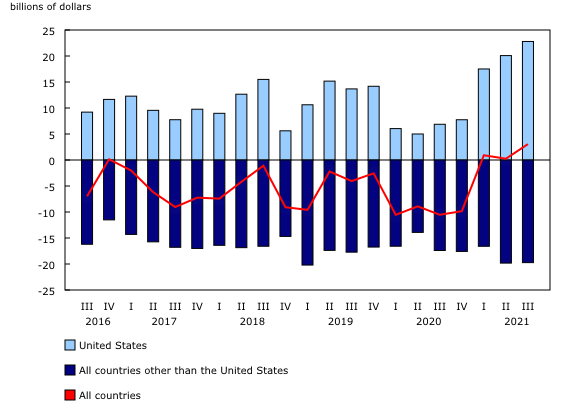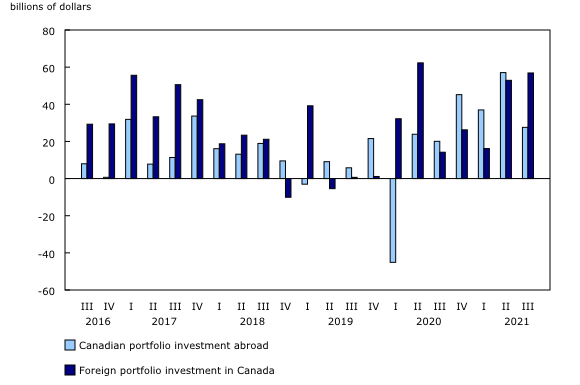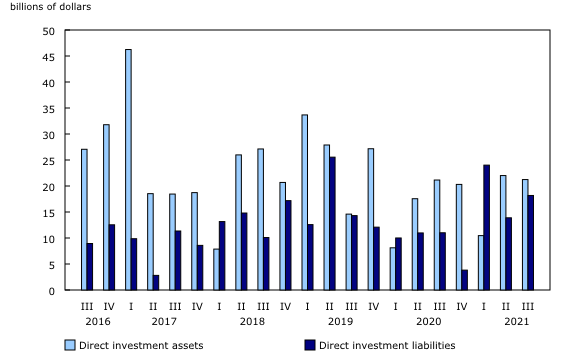Canada's balance of international payments, third quarter 2021
Archived Content
Information identified as archived is provided for reference, research or recordkeeping purposes. It is not subject to the Government of Canada Web Standards and has not been altered or updated since it was archived. Please "contact us" to request a format other than those available.
Released: 2021-11-29
$1.4 billion
Third quarter 2021
Canada's current account balance (on a seasonally adjusted basis) remained in a surplus position in the third quarter, as overall international receipts exceeded payments by $1.4 billion. After posting continuous deficits from the fourth quarter of 2008 until the end of 2020, the current account balance has recorded a surplus position in all quarters of 2021.
The surplus in the third quarter was unchanged from the second quarter but reflected a higher trade in goods surplus, largely offset by a lower investment income surplus.
In the financial account (unadjusted for seasonal variation), transactions in currency and deposits led the net lending activity to non-residents through a reduction in foreign holdings of these instruments in Canada. Foreign direct investment was also a contributor as direct investment abroad exceeded direct investment in Canada.
Current account
Trade in goods and services remains in a surplus position
The trade in goods and services balance posted a third consecutive surplus, up $1.6 billion to $1.8 billion in the third quarter. This surplus was led by higher exports of goods. Meanwhile, the trade in services balance recorded a second consecutive deficit as imports grew by more than exports in the quarter.
Exports of goods were up by $7.5 billion to $160.4 billion in the third quarter. The largest contributor was energy products, up $5.9 billion through higher prices and volumes. This increase was moderated by lower exports of forestry products, as prices declined 14.9% after increasing by more than 55% over the previous four quarters.
Imports of goods rose by $4.7 billion to $157.4 billion in the quarter. Imports of motor vehicles and parts increased by $1.7 billion but remained lower than their pre-pandemic levels as supply issues for semiconductor chips continue to affect this industry.
On a geographical basis, the goods surplus with the United States was up by $2.7 billion in the third quarter, with exports increasing more than imports. The deficit with countries other than the United States was slightly reduced. Increased trade activity with the United Kingdom was moderated by a decline with China.
The trade in services deficit increased $1.2 billion to reach $1.3 billion in the third quarter. The travel surplus was down $0.8 billion as international travel activity increased. The number of Canadian and foreign tourists reached their highest levels since the beginning of the pandemic. The transport deficit increased $0.5 billion, mostly on larger imports of sea transport.
Profits on direct investment increase
The investment income surplus was down by $3.1 billion to $0.4 billion in the third quarter. This reduction largely resulted from a lower direct investment surplus. During the third quarter, profits earned by foreign direct investors in Canada were up $1.9 billion to a record-high $15.1 billion. Meanwhile, profits earned by Canadian direct investors on their assets abroad were up by $0.4 billion to $21.7 billion.
Financial account
Foreign investment in Canadian bonds up significantly
Foreign investment in Canadian securities amounted to $56.9 billion in the third quarter, the highest level since the second quarter of 2020. The investment activity mainly targeted Canadian private corporate securities, notably bonds.
New issues of Canadian private corporate bonds placed in foreign markets, largely denominated in foreign currencies, accounted for the bulk of the investment activity. Foreign acquisitions of corporate short-term instruments and equities also contributed but to a lesser extent. Canadian stock prices edged down, and the Canadian dollar depreciated slightly against its US counterpart in the quarter.
On the other side of the ledger, Canadian investors acquired $27.6 billion in foreign securities in the third quarter, down from $57.1 billion in the second quarter. Investors mainly targeted US shares and non-US foreign bonds in the third quarter. US stock prices, as measured by the Standard and Poor's 500 composite index, edged down in the third quarter.
Direct investment in Canada increases
Direct investment in Canada totalled $18.2 billion in the third quarter, up from $13.9 billion in the second quarter. The level of investment reached in the first three quarters of the year has already exceeded the level observed for the whole year of 2020. Mergers and acquisitions activity totalled $4.6 billion in the third quarter, up from $1.6 billion in the second quarter. Foreign direct investment was mainly in both the energy and mining and manufacturing industries in the quarter. On a country basis, foreign direct investment from the United States and Switzerland accounted for more than half of the quarterly flows.
Direct investment abroad was $21.2 billion in the third quarter compared with $22.0 billion in the second quarter. Merger and acquisition activity reached $11.5 billion, the highest level since the first quarter of 2019. The highest proportion of the direct investments abroad was in the financial sector. One-third of all Canadian investment abroad was directed to the United States in the third quarter.
Canada's international official reserves generate significant movements of funds
Canada's official international reserves increased by $23.3 billion in the third quarter. This increase was mainly the result of the International Monetary Fund implementing a new allocation of Special Drawing Rights to its member countries during the quarter, which added $18.9 billion to both reserve assets and long-term liabilities. This allocation will benefit all member countries to address their long-term global needs for reserves and maintain the stability of the global economy. The last general allocation was implemented in 2009 to provide liquidity in the context of the global financial crisis.
Note to readers
Definitions
The balance of international payments covers all economic transactions between Canadian residents and non-residents in three accounts: the current account, the capital account and the financial account.
The current account covers transactions in goods, services, compensation of employees, investment income and secondary income (current transfers).
The current account data in this release are seasonally adjusted. For information on seasonal adjustment, see Seasonally adjusted data – Frequently asked questions.
The capital account covers capital transfers and transactions in non-produced, non-financial assets.
The financial account covers transactions in financial assets and liabilities.
In principle, a net lending (+) or net borrowing (-) derived from the sum of the current and capital accounts corresponds to a net lending (+) or net borrowing (-) derived from the financial account. In practice, as data are compiled from multiple sources, this is rarely the case and gives rise to measurement error. The discrepancy (net errors and omissions) is the unobserved net inflow or outflow.
Foreign direct investment is presented on an asset-liability principle basis (that is, gross basis) in the financial account. Foreign direct investment can also be presented on a directional principle basis (that is, net basis), as shown in supplementary foreign direct investment tables 36-10-0025-01, 36-10-0026-01, 36-10-0473-01 and 36-10-0656-01. The difference between the two foreign direct investment conceptual presentations resides in the classification of reverse investment such as (1) Canadian affiliates' claims on foreign parents and (2) Canadian parents' liabilities to foreign affiliates. Under the asset-liability presentation, (1) is classified as an asset and included in direct investment assets, also referred to as direct investment abroad in this text, and (2) is classified as a liability and included in direct investment liability, also referred to as direct investment in Canada in this text.
For more information on the balance of payments, consult "Chapter 8. International Accounts," in the User Guide: Canadian System of Macroeconomic Accounts, available on our website. The chapter also presents the most recent balance of payments statistics.
Real-time table
Real-time table 36-10-0042-01 will be updated on December 6. For more information, see Real-time tables.
Revisions
This release incorporates statistical revisions back to 2018 as part of the annual revision exercise of the Canadian System of Macroeconomic Accounts. Revisions reflect, in large part, the integration of benchmark survey data and updates resulting from the integration of trade data in the broader analytical context of the supply-use tables.
Revisions also reflect the integration of new data sources as well as updates to coverage and statistical methods, including the introduction of updated seasonal factors contributing to revisions to quarterly figures and patterns.
Overall, the impact of these updates led to lower exports of goods for most quarters during the period, mainly due to a reduction of the under coverage estimate for export transactions. For imports, the most notable impact was on natural gas, for which new data sources were integrated. These changes were introduced mainly in light of the integration of trade data in the supply-use tables.
For trade in services, both exports and imports were revised upward from 2018. Multiple factors contributed to these updates, led by the integration of benchmark survey data but also by the enhanced coverage of enterprises involved in the digital economy. For more details on sources of revisions for services, please consult the latest annual and monthly international trade in services releases.
In the financial account of the balance of payments, in addition to the typical integration of new benchmark survey data, updates to federal government debt securities data were implemented, due to the inclusion of additional details related to the geographical distribution of investors.
Next release
Balance of international payments data for the fourth quarter will be released on February 28, 2022.
Products
The product Canada's international trade and investment country fact sheet (71-607-X2020001) is available online. This product provides easy and centralized access to Canada's international trade and investment statistics, on a country by country basis. It contains annual information for nearly 250 trading partners in summary form, including charts, tables and a short analysis that can also be exported in PDF format.
The product Canada and the World Statistics Hub (13-609-X) is available online. This product illustrates the nature and extent of Canada's economic and financial relationship with the world using interactive graphs and tables. This product provides easy access to information on trade, investment, employment and travel between Canada and a number of countries, including the United States, the United Kingdom, Mexico, China and Japan.
The Economic accounts statistics and International trade statistics portals are available from the Subjects module of our website.
The product Methodology for Exports of Energy Products within the International Merchandise Trade Program, which is part of Latest Developments in the Canadian Economic Accounts (13-605-X), is available.
The Methodological Guide: Canadian System of Macroeconomic Accounts (13-607-X) is available.
The User Guide: Canadian System of Macroeconomic Accounts (13-606-G) is also available.
Contact information
For more information, contact us (toll-free 1-800-263-1136; 514-283-8300; infostats@statcan.gc.ca).
To enquire about the concepts, methods or data quality of this release, contact Denis Caron (statcan.mediahotline-ligneinfomedias.statcan@statcan.gc.ca), International Accounts and Trade Division.
- Date modified:





